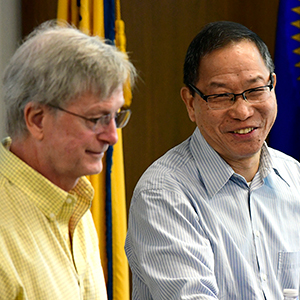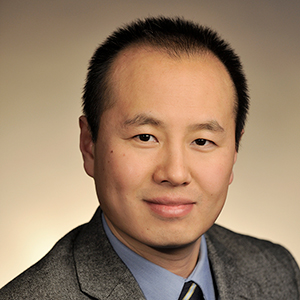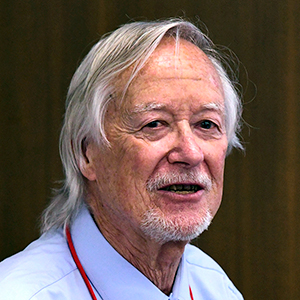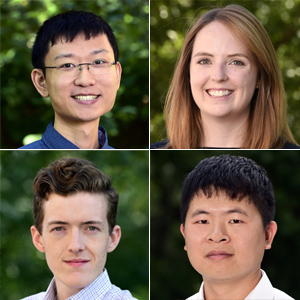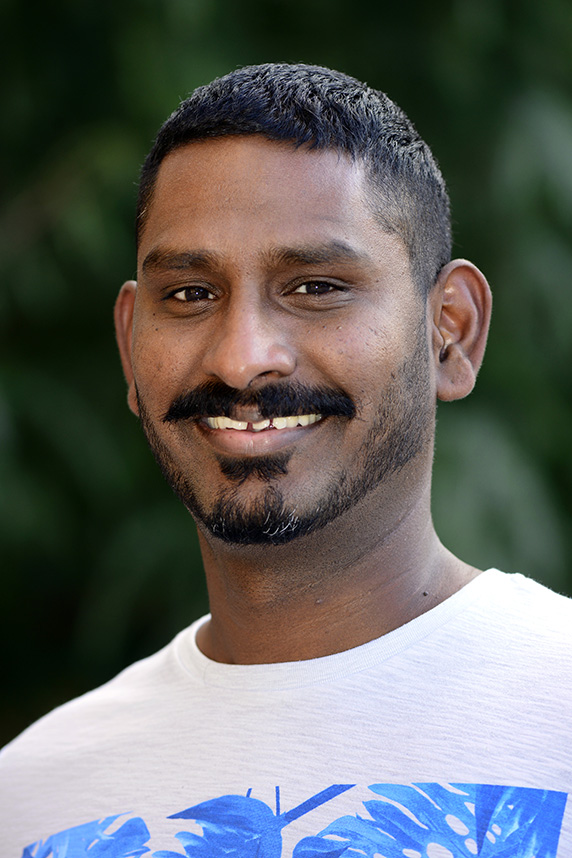 Jothi holds a secondary appointment in the Biostatistics and Computational Biology Branch. (Photo courtesy of Steve McCaw)
Jothi holds a secondary appointment in the Biostatistics and Computational Biology Branch. (Photo courtesy of Steve McCaw)A recent study led by NIEHS scientist Raja Jothi, Ph.D., may answer a question about the beginning of a process known as DNA transcription. The team reported that a protein called NF-Y directs transcription so it begins at the right place.
The first step for making a protein in a cell involves copying — or transcribing — the DNA sequence of a gene into messenger RNA (mRNA). RNA Polymerase II (Pol II) is the name for the machinery responsible for this transcription process.
Where to begin?
Pol II binds to the beginning of a gene, known as the promoter. Interestingly, a promoter may contain more than one site where Pol II can begin transcribing. Jothi wanted to find out how Pol II chooses one transcription start site (TSS) over another. He and his team thought a compound called NF-Y held the key.
Members of Jothi’s Systems Biology Group and their collaborators knew that NF-Y typically blocks Pol II from starting transcription from the wrong site. When they removed NF-Y from mouse embryonic stem cells, Pol II started transcribing from an incorrect TSS. The resulting mRNA contained errors and might have resulted in mutant proteins.
Jothi originally thought transcription was tightly controlled and was surprised to find that deleting a single factor would have such a major effect. He and his colleagues concluded that NF-Y protects against abnormal initiation of transcription. 'NF-Y funnels the Pol II transcriptional machinery to the correct TSS while physically blocking other TSSs,' Jothi said.
 'NF-Y’s role as a central player in TSS selection in animals highlights the negative consequences of inaccurate transcription initiation,' Kumar said. (Photo courtesy of Steve McCaw)
'NF-Y’s role as a central player in TSS selection in animals highlights the negative consequences of inaccurate transcription initiation,' Kumar said. (Photo courtesy of Steve McCaw)Dhirendra Kumar, Ph.D., a visiting fellow in Jothi’s group and one of the study’s co-authors, further explained that by acting as an enforcer to ensure the correct TSS is used, NF-Y protects against any negative consequences of starting transcription from the wrong place.
Building on previous work
Jothi and his team have been studying NF-Y for a few years. In 2014, they published a paper in Molecular Cell that reported that NF-Y is the first transcription factor to arrive at DNA. It opens the chromatin in a way that allows later-arriving transcription factors to reach their proper sites. Once that happens, the enhancer becomes active, regulating gene expression.
Jothi explained that although enhancers are DNA sequences that are located far away from genes, they are able to bind transcription factors and regulate those distant genes.
Using an approach called ChIP-seq, the researchers identified approximately 5,000 NF-Y binding sites across the whole genome. Roughly half of them were at enhancers, whereas the other half were immediately upstream of genes at promoters. For the Molecular Cell paper, team members studied NF-Y function at the enhancers. For the current paper, they examined the other half, which is NF-Y function at the promoters.
Directing traffic
Jothi said a way to think about what NF-Y does is to visualize a multilane highway with scores of vehicles. If an accident or other circumstance causes lanes to be closed, police step in to redirect traffic.
'By standing in front of the affected lanes, the cop is saying, 'You all are all driving toward me, but these lanes are blocked; use the open lane,'' Jothi said. 'In the case of NF-Y, it directs Pol II to go to the right transcription start site, but not the other possibilities.'
 In Jothi’s analogy, NF-Y acts as a traffic cop, directing Pol II traffic to the correct TSS lane while blocking other TSS lanes.
In Jothi’s analogy, NF-Y acts as a traffic cop, directing Pol II traffic to the correct TSS lane while blocking other TSS lanes.Other scientists are excited about Jothi’s findings. Fellow NIEHS researcher Joseph Rodriguez, Ph.D., head of the Single Cell Dynamics Group, said the work shows that NF-Y defines where transcription starts by how it organizes the chromatin structure of the promoter.
'It will be exciting to see if other factors function similarly and whether this mechanism is manipulated to select alternative transcription start sites,' he said.
Citations:
Oldfield AJ, Henriques T, Kumar D, Burkholder AB, Cinghu S, Paulet D, Bennett BD, Yang P, Scruggs BS, Lavender CA, Rivals E, Adelman K, Jothi R. 2019. NF-Y controls fidelity of transcription initiation at gene promoters through maintenance of the nucleosome-depleted region. Nat Commun 10(1):3072.
Oldfield AJ, Yang P, Conway AE, Cinghu S, Freudenberg JM, Yellaboina S, Jothi R. 2014. Histone-fold domain protein NF-Y promotes chromatin accessibility for cell type-specific master transcription factors. Mol Cell 55(5):708−722.





